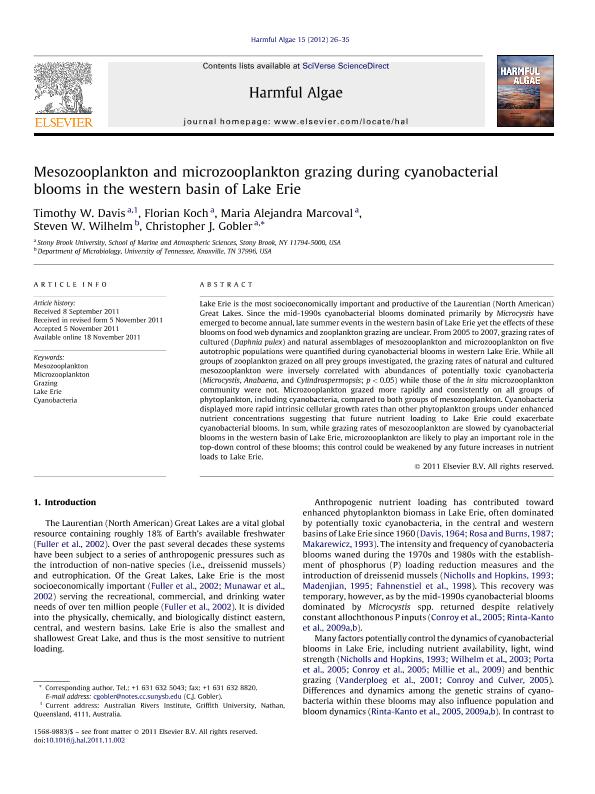Mostrar el registro sencillo del ítem
dc.contributor.author
Davis, Timothy W.
dc.contributor.author
Koch, Florian
dc.contributor.author
Marcoval, Maria Alejandra

dc.contributor.author
Wilhelm, Steven W.
dc.contributor.author
Gobler, Christopher J.
dc.date.available
2023-06-06T11:19:34Z
dc.date.issued
2012-03
dc.identifier.citation
Davis, Timothy W.; Koch, Florian; Marcoval, Maria Alejandra; Wilhelm, Steven W.; Gobler, Christopher J.; Mesozooplankton and microzooplankton grazing during cyanobacterial blooms in the western basin of Lake Erie; Elsevier Science; Harmful Algae; 15; 3-2012; 26-35
dc.identifier.issn
1568-9883
dc.identifier.uri
http://hdl.handle.net/11336/199674
dc.description.abstract
Lake Erie is the most socioeconomically important and productive of the Laurentian (North American) Great Lakes. Since the mid-1990s cyanobacterial blooms dominated primarily by Microcystis have emerged to become annual, late summer events in the western basin of Lake Erie yet the effects of these blooms on food web dynamics and zooplankton grazing are unclear. From 2005 to 2007, grazing rates of cultured (Daphnia pulex) and natural assemblages of mesozooplankton and microzooplankton on five autotrophic populations were quantified during cyanobacterial blooms in western Lake Erie. While all groups of zooplankton grazed on all prey groups investigated, the grazing rates of natural and cultured mesozooplankton were inversely correlated with abundances of potentially toxic cyanobacteria (Microcystis, Anabaena, and Cylindrospermopsis; p < 0.05) while those of the in situ microzooplankton community were not. Microzooplankton grazed more rapidly and consistently on all groups of phytoplankton, including cyanobacteria, compared to both groups of mesozooplankton. Cyanobacteria displayed more rapid intrinsic cellular growth rates than other phytoplankton groups under enhanced nutrient concentrations suggesting that future nutrient loading to Lake Erie could exacerbate cyanobacterial blooms. In sum, while grazing rates of mesozooplankton are slowed by cyanobacterial blooms in the western basin of Lake Erie, microzooplankton are likely to play an important role in the top-down control of these blooms; this control could be weakened by any future increases in nutrient loads to Lake Erie
dc.format
application/pdf
dc.language.iso
eng
dc.publisher
Elsevier Science

dc.rights
info:eu-repo/semantics/openAccess
dc.rights.uri
https://creativecommons.org/licenses/by-nc-sa/2.5/ar/
dc.subject
CYANOBACTERIA
dc.subject
GRAZING
dc.subject
LAKE ERIE
dc.subject
MESOZOOPLANKTON
dc.subject
MICROZOOPLANKTON
dc.subject.classification
Biología Celular, Microbiología

dc.subject.classification
Ciencias Biológicas

dc.subject.classification
CIENCIAS NATURALES Y EXACTAS

dc.title
Mesozooplankton and microzooplankton grazing during cyanobacterial blooms in the western basin of Lake Erie
dc.type
info:eu-repo/semantics/article
dc.type
info:ar-repo/semantics/artículo
dc.type
info:eu-repo/semantics/publishedVersion
dc.date.updated
2023-06-05T11:58:29Z
dc.journal.volume
15
dc.journal.pagination
26-35
dc.journal.pais
Países Bajos

dc.journal.ciudad
Amsterdam
dc.description.fil
Fil: Davis, Timothy W.. Griffith University; Australia
dc.description.fil
Fil: Koch, Florian. Griffith University; Australia
dc.description.fil
Fil: Marcoval, Maria Alejandra. Consejo Nacional de Investigaciones Científicas y Técnicas. Centro Científico Tecnológico Conicet - Mar del Plata; Argentina
dc.description.fil
Fil: Wilhelm, Steven W.. University of Tennessee; Estados Unidos
dc.description.fil
Fil: Gobler, Christopher J.. Griffith University; Australia
dc.journal.title
Harmful Algae

dc.relation.alternativeid
info:eu-repo/semantics/altIdentifier/url/https://www.sciencedirect.com/science/article/pii/S1568988311001594
dc.relation.alternativeid
info:eu-repo/semantics/altIdentifier/doi/http://dx.doi.org/10.1016/j.hal.2011.11.002
Archivos asociados
